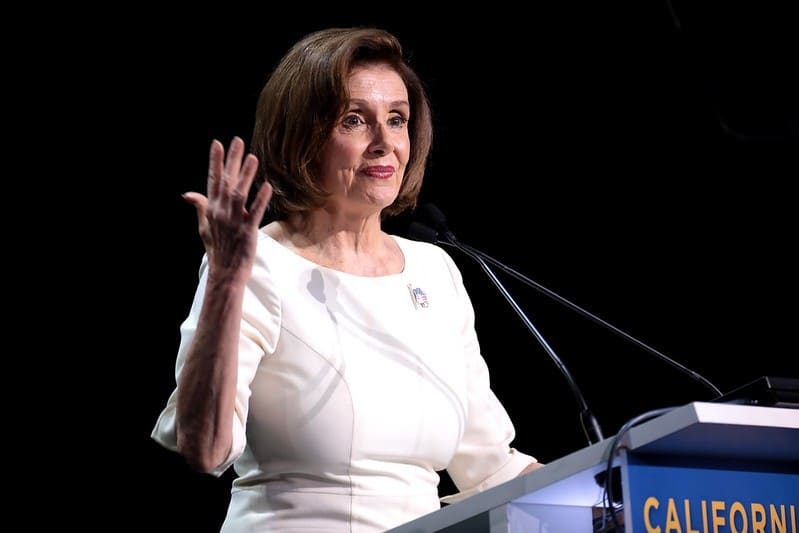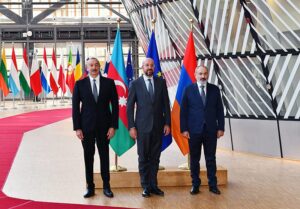Nancy Pelosi speaking on the California Democratic Party State Convention, 2019 (Source: Flickr)
With a broad smile, Nancy Pelosi received a bouquet of flowers from Armenian Prime Minister Nikol Pashinyan during her official visit to the country on the 18th of September. The U.S. House of Representatives Speaker used her visit to Armenia to express support for Yerevan amid the conflict with Azerbaijan and reignited tensions in the region. Pelosi’s visit strategically comes at a time when Russia – Armenia’s most important ally – is dealing with unrest in its geopolitical backyard.
Pelosi holds Azerbaijan accountable for renewed conflict
Violence recently broke out again between Armenia and Azerbaijan over the long-running Nagorno-Karabakh conflict. While a ceasefire is currently holding, Pelosi led a US delegation in an official visit to Yerevan. Armenia is traditionally an ally of Russia and is a member of the Russian-led Collective Security Treaty Organization (CSTO). The CSTO can be seen as an equivalent of the NATO and is an Eurasian intergovernmental military alliance consisting of 6 members and has a mutual assistance article which compares itself to NATO’s fifth article. Besides Russia and Armenia, the other members are Belarus, Kazakhstan, Kyrgyzstan and Tajikistan.
During Pelosi’s visit, she pledged support from the United States for the Armenian side and blamed Azerbaijan for “illegal and deadly attacks by Azerbaijan on Armenian territory.” The foreign ministry of Azerbaijan rejected the comments by Pelosi, calling them “unsubstantiated and unfair accusations”. Russia, which strives for a friendly relationship with Azerbaijan, has called upon both sides to find an exclusively diplomatic and political resolution for the conflict. In previous skirmishes between Armenia and Azerbaijan back in 2020, Russia brokered a ceasefire after 6 weeks of fighting which resulted in 6,500 casualties. Since then, 2,000 Russian peacekeepers were deployed in the Armenian-controlled territory.
Armenia expressed its dissatisfaction with the CSTO treaty after Yerevan’s requests for aid failed to elicit a response from Russia. Although Armenia asked for an intervention by the CSTO, it was only a fact-finding team that was sent to the region. Parliamentary speaker Alen Simonyan compared the CSTO on national television to a “pistol that did not shoot bullets.” Pelosi said that she found Armenia’s dissatisfaction with CSTO’s response “interesting”.
Unrest in the CSTO
CSTO members’ failure to respond to the Armenian-Azerbaijani conflict is understandable, given the political and military unrest prevailing in the member states. Last week, fierce fighting also broke out on the border between CSTO member states Kyrgyzstan and Tajikistan, resulting in what is already the deadliest clash between both countries in years. The reason for the skirmishes is a dispute between the two countries about the poorly demarcated border. Violent clashes between Kyrgyzstan and Tajikistan took place back in 2021 as well, in which at least 50 people were killed. Because of the new clashes, the fear that the dispute can turn into a full-scale war between both countries remain. Similar to the clashes between Azerbaijan and Armenia, Russia has called for a peaceful and diplomatic resolution between both parties.
The start of 2022 was marked in Kazakhstan by large anti-government protests and excessive violence against protesters, resulting in 200 deaths. Kazakh president Kassym-Jomart Tokayev described the protests as a coup d’état attempt. Eventually, CSTO forces had to step in to restore order in Kazakhstan and remained in the country for 2 weeks. Belarus witnessed widespread upheaval in the summer of 2020, with large-scale protests against Lukashenko’s fraudulent re-election. In addition, Belarusian participation in the invasion of Ukraine prompted several far-reaching sanctions against the country. At the moment, Russia is having its hands full in Ukraine, where the Ukrainian counter-offensive in the Kharkiv Oblast puts Putin’s government in a bad light. Hence, further escalating political unrest among allies would be extremely ill-timed for Putin.
Russian silence opens new doors
Pelosi’s notion that Armenia’s disappointment with the absence of aid from Russia is “interesting” gives an indication of how the situation is perceived. The CSTO as a Moscow-led organization has lost vigor despite Putin’s assurance that Russia can act as a mediator. The promises that Russia has enough resources to intervene despite the war in Ukraine has not yet materialized in practice.
Various conflicts and political instability in member states means that the CSTO is currently more of a headache for Putin, than that it provides for the enhancement of Russia’s sphere of influence in Eurasia. It is interesting to see how other countries respond to the fragility of the situation. For instance, Prime Minister Macron of France, a country that has strong ties with Armenia, and now the United States have already expressed their support for the country. Undoubtedly, had it not been for losses in Ukraine, Putin would likely have reacted more adequately to Armenian requests to prevent deterioration of Russian-Armenian relations. Now that the war in Ukraine has reached an unfavorable tipping point from a Russian perspective and instability in the Caucasus and Central Asia is evolving in armed conflict, rapprochement and intervention from other global powers is likely to happen.
Author: Mathieu Neelen
Sources: AlJazeera1, AlJazeera2, BBC1, BBC2, Euronews1, Euronews2, HumanRightsWatch, Reuters1, Reuters2, Reuters3
Photo: Flickr



